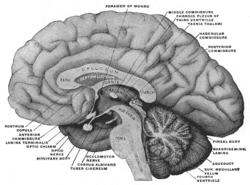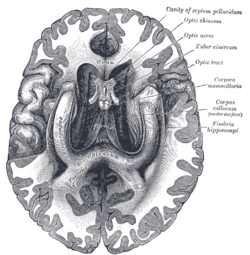Tuber cinereum
| Tuber cinereum | |
|---|---|
 Base of brain (Tuber cinerum visible at center). | |
| Details | |
| Identifiers | |
| Latin | Tuber cinereum |
| MeSH | A08.186.211.730.385.357.352.870 |
| NeuroNames | hier-376 |
| NeuroLex ID | Tuber cinereum |
| TA | A14.1.08.408 |
| FMA | 62327 |
The tuber cinereum is a hollow eminence of gray matter situated between the mammillary bodies and the optic chiasm. The tuber cinereum is part of the hypothalamus.
Structure
Laterally it is continuous with the anterior perforated substances and anteriorly with a thin lamina, the lamina terminalis.
The infundibulum, a hollow conical process, projects from the tuber cinereum. The infundibulum extends forward and down where it is attached to the posterior lobe of the pituitary gland.
It houses the nuclei:
- tuberal nucleus
- tuberomammillary nucleus[1]
Tuberomammillary nucleus
The tuberomammillary nucleus (TMN) is the sole source of histamine in the brain.[2]
Function
Circadian rhythm
By its release of histamine, the tuberomammillary nucleus of the tuber cinereum helps to regulate the circadian cycle.
Additional images
 Mesal aspect of a brain sectioned in the median sagittal plane.
Mesal aspect of a brain sectioned in the median sagittal plane. The fornix and corpus callosum from below.
The fornix and corpus callosum from below.
See also
References
This article incorporates text in the public domain from the 20th edition of Gray's Anatomy (1918)
- ↑ patients.uptodate.com - Abstracts for References 5 and 6 of 'Hypothalamic-pituitary axis'
- ↑ ingentaconnect.com - IngentaConnect Estrogen receptors and metabolic activity in the ...
External links
- Atlas image: n1a8p1 at the University of Michigan Health System - "Interpeduncular fossa" (#4)